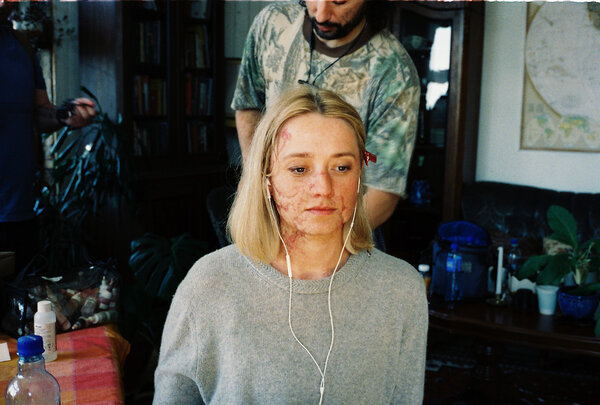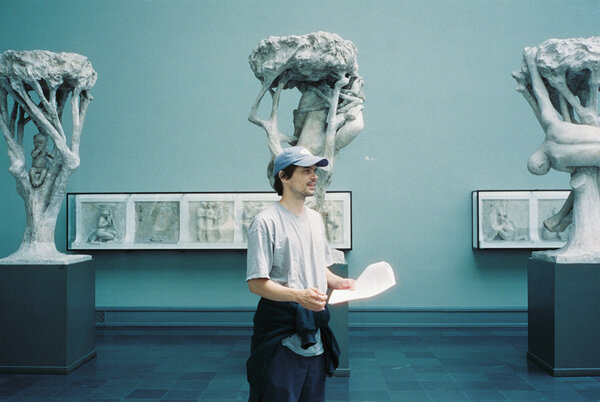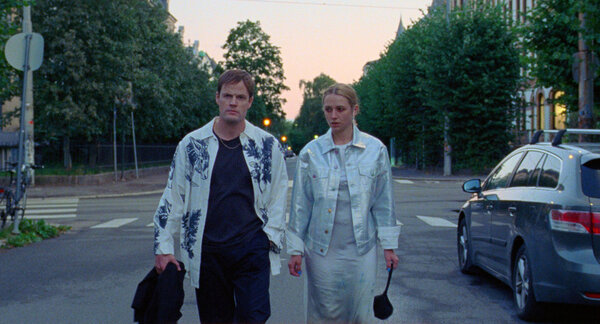Festival de Cannes 2022
Benjamin Loeb, FNF, discusses the making of "Sick of Myself" by Kristoffer Borgli
Beauty MarkWhen Signe’s partner suddenly meets with huge success as an artist, she begins to create a special identity for herself.
This year there has evidently been a comeback of 16mm… What do you think this is due to ?
Benjamin Loeb : I think the desire for 16mm is coming back simply because 35mm has become so clean over the years. As a filmmaker growing up in the 1980s to 1990s, in the heart of film cinematography, to suddenly realize in your career that all of that has more or less disappeared is certainly heartbreaking. It’s a bit like looking nostalgically at family photos where your whole childhood is bathed in the grain of Ektachrome ! And then there is the race towards ever larger sensors with ever more definition. It has nothing to do with the industrial decisions of the manufacturers. In the end, we don’t care a bit about the number of pixels and data that each camera is able to handle. All that matters to me is the feeling of what suits the film and what pleases my eye. For example, on the Alexa Mini, my favorite mode is the one where we only use the center of the sensor in Super 16 crop. It’s just more beautiful that way... The images seem more accurate to me that way. That’s why I shot After Yang, a film by Kogonada with Colin Farrell in 2020, with the camera being equipped with a simple Canon 8-64mm zoom. The rendering is not super vintage, or super grainy... It’s just that this combination creates a perfect harmony.

What about the depth of field ?
BL : Shooting scenes with one eye in focus and the other blurry is kind of like trying to mask a blemish. If you’re shoot with a good production designer, or in beautiful locations, why wouldn’t you want to show them more ? I sincerely believe that 16mm, as a means of expression, will continue to be part of the vocabulary of filmmakers for years to come. The only slightly sad thing is that we are limited in the choice of short focus lenses. And I would really like it if some manufacturers would remedy this in the lenses they release every month. On the Jesse Eisenberg film, I chose the classic Primos. I am very lucky to have been able to work with Panavision on all my films and I admit that these spherical Primos are my favorite lenses and the ones I come back almost every time. In 16 mm, we then only use part of the glass, and it is perhaps not exactly the same rendering as when we use them in 35 mm, for which they were manufactured. But I really like their rendering as long as you don’t really need really wide lenses. I also feel like Panavision, through the custom service they provide for each film, really listens to cinematographers. I admire the work of Dan Sasaki’s team, and this idea that we can go into the lenses and adapt them to each project. Sometimes, I think I should take time off and do a long internship with a lens manufacturer to gain a better understanding and mastery over my images !

Tell me about how you met Kristoffer Borgli, the director of Sick of Myself.
BL : First of all, I was a big fan of his short films. Discovering this feature screenplay first made me think of the universe he had developed in his short films. After our initial meetings, Kristoffer immediately mentioned film and said he didn’t imagine his film in digital. Not that the intention was to anchor it in a sort of reference to cinema of bygone times, but rather because of the discipline and the imperfections that I’ve already mentioned. We then began discussing this with the producers, who formally replied that it was out of the question given the budget. We therefore proposed to them : what if we shoot with five fewer days ? And then, discussions began to figure out if the film could actually be shot in thirty days instead of the thirty-five initially planned. At the same time, Kodak Great Britain helped us a lot. In the end, we chose 35mm 2 perf, with a negative size almost approaching that of S 16mm, and shooting about an hour of dailies every day. This is where the choice of film has meaning for the way you make a film. You can’t shoot as many shots as you want and the choices have to be made more on set, less during editing. At the end of the day, you sometimes even feel a bit insecure, for example when you know that, on a close-up of the main actress, she will only be entitled to two takes. Especially when you know how essential the flow and the rhythm of an actress are.
How does he work on set ?
BL : Kristoffer is still a big fan of leaving his actors freedom to interpret the scene on set. It’s a bit like “press ‘play’” ! This method was often used on the film, generally covering the first master shot, which was a bit wide, so as to see everyone and leave space for the actors’ performance. For example, the scene where our protagonist is shooting a commercial and where blood starts to run down his face. Just with this master and everyone in the field (including Kristoffer who plays the director himself), it was hilarious. There, the wide shot informs us of everything that has to be included in the scene, and I must say that Kristoffer is very good at bringing this kind of shot to life. So afterwards, what remains is to take the closer shots and, especially on this film with two main characters who spend their time jostling to be at the center of the story and the camera ! That’s when Kristoffer had the idea of integrating this kind of fight into the camera work. This results in frequent side pans where I would go from one to the other according to the dialogues and the situations. Most of the time, it was improvisation until Kristoffer decided to tape pages of the screenplay to my back, standing just behind me and following the lines so as to indicate to me when I should anticipate the next move by giving me a little tap on the shoulder !

The image is indeed very often in motion, whether in traveling or zooming...
BL : Most of the time we were on a dolly, and I also took out the Angénieux Optimo 24-290mm quite a few times. The tracking shot is a kind of extroverted movement to me, while the zoom is more introverted. This mixture really shapes the style of the film. In a way, it is a very simple and basic language that also provides consistency throughout the whole film.
Was it easy for you to find a photochemical laboratory for the project ?
BL : We’re lucky in Scandinavia, we still have a silver-process lab (in Stockholm). But we ended up at Cinelab in London with this film. Mainly because they gave us a very competitive package deal. They are the ones who developed all our negatives and scanned them with extraordinary care. This is something that I want to emphasize, because too often nowadays you can end up with a negligent photochemical chain, as respect for the negative is becoming lost with the advent of digital. Julien Alary took care of the color grading, he had also finalized The Worst Person in the World, also shot in 35mm by Kasper Tuxen last year.
What did you take away from this shoot ?
BL : I’m very pleased to have been able to make this film in such close collaboration with the director. This is one of the first films in my career where a creative discussion took place from start to finish. We also had detailed discussions with the producers, and the director’s vision completely guided the major decisions made about how to make this film. It was very different from the usual method one usually finds where you’ve got to fill up Excel files with tons of numbers and data so the production algorithm tells you how many days of shooting you’re entitled to, and what cameras and locations will be possible.
Sick of Myself was, first and foremost, a conversation between filmmakers, and that’s all one can ask for on any project !
(Interview by François Reumont, for the AFC, translated from French by A. Baron-Raiffe)
 En
En Fr
Fr





